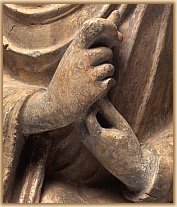The most widely known mudra in Japan are those associated with the Five Buddha of Wisdom (Jp = Godai Nyorai, Gochi Nyorai), a grouping that originated in India, as did most Buddhist iconography. The five are eminations of Buddha nature. They embody five fundamental wisdoms -- wisdom against anger, envy, desire, ignorance, and pride -- to help us break free from the cycle of death and rebirth (samsara). Each of the five has a specific mudra that corresponds to one of the five defining episodes in the life of the Historical Buddha (see charts below). Each of the five is also associated with a compass direction, color, and other attributes. In Japan, only two of the Five Buddha are still widely reverred.

The five are:
Teaching Mudra, Dainichi Nyorai (Vairocana) | Center | White | Well known in Japan.
Fear Not Mudra, Fukūjōju Nyorai (Amoghasiddhi) | North | Green
Welcome Mudra, Hōshō Nyorai (Ratnasambhava) | South | Yellow
Earth-Touching Mudra, Ashuku Nyorai (Akshobhya) | East | Blue
Meditation Mudra, Amida Nyorai (Amitabha) | West | Red | Well known in Japan."
See other well-known mudra are also presented [on Onmarkproductions]
More Info...